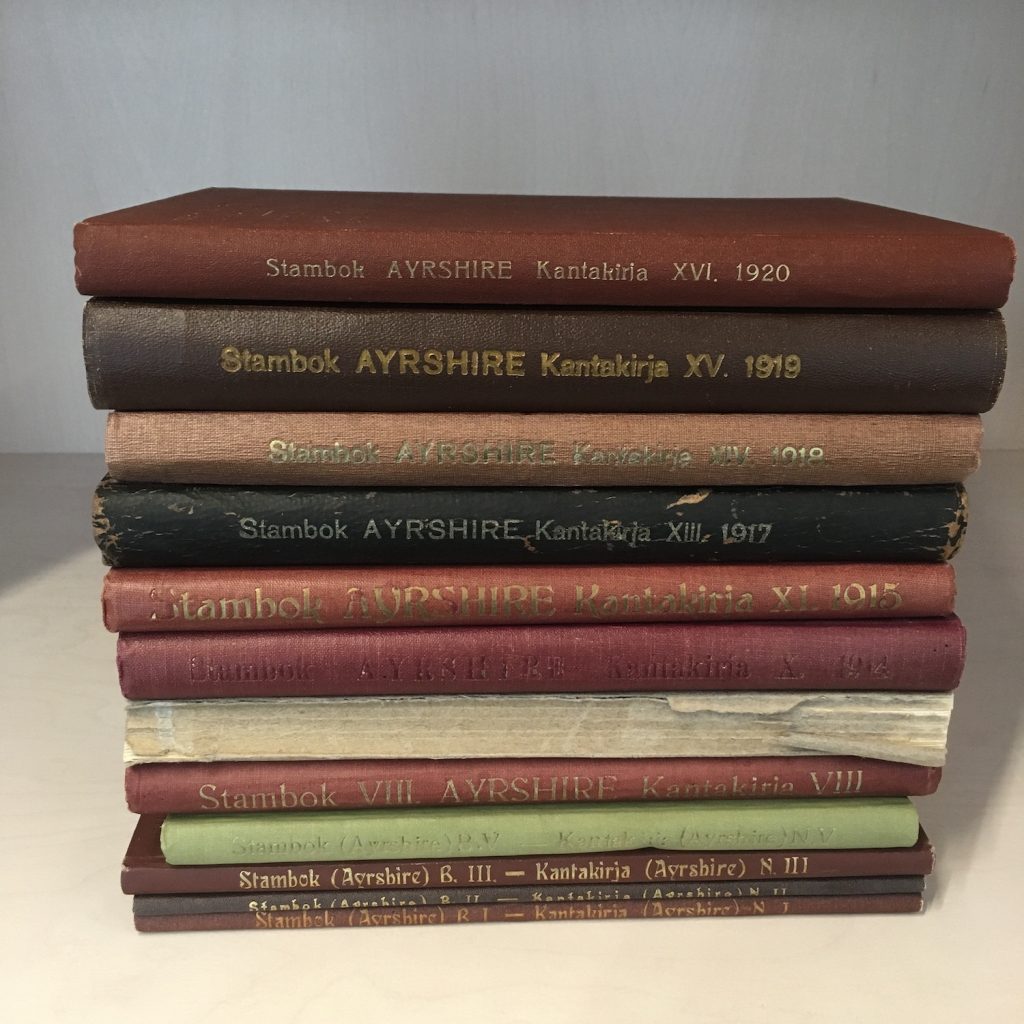Ladies, Lords and Erkki Bill – herd-books of the Ayrshire Cattle
JULY 2018
At the beginning of the 20th century, Gösta Serlachius and G. A. Serlachius Ltd. bred Ayrshire Cattle in Mänttä. As a reminiscence of this, in the library of the Serlachius Museums you find a publication series with flexible binding called Kantakirja ayrshirerotuisesta nautakarjasta Suomessa (Herd-book of the Ayrshire Cattle in Finland). The herd-books reveal that a little more than one hundred years ago, cows and bulls in Finnish farms could have just as solemn names as any race horse ever, names that might even cause some amusement.
The Ayrshire is a Scottish cattle breed, which was came to Finland for the first time in 1845 from Germany. The breed was productive and it adapted well to Finnish conditions. At the end of the 19th century, the agricultural authorities started a policy of creating especially Finnish landraces and Ayrshire cattle, which today is the most common breed of dairy cattle in our country. A person travelling in Finland in summer recognizes an Ayrshire cow by its white-brown colour and the fact that it’s considerably more light-build than the beef cattle breeds.
In Finland, the Ayrshire cattle were first registered in the herd-book in 1897. By the turn of the century, bulls were annually registered in the herd-book at the bull exhibitions organized in summer; the cows were examined at their owner’s farm. The first volume of the herd-book of the Finnish Ayrshire Association came out in 1903. In this publication, the bulls and cows were divided into A the herd-book and B the master list in numerical order. Following the same system, from then on they produced information in a book on the animals that they had accepted into the herd-book during the year. In these publications, there was a register of the names of the animals, and soon enough, also a list of the names of the original breeding farms.
The growth in the number of Ayrshire cattle demonstrated also the fact that the 1903 list of the names of the cattle was three pages long, whereas in 1920 the list was 15 pages long. Just for the breeding and the registering of the cattle in the herd-book, it was not obligatory to name the cattle, but in any case it has not been a common practice to use just the registration number. In the herd-book published in 1903, every animal has a name.
On the basis of the herd-books, Ayrshire cattle in Scotland have had their names after their breeder farm, in the same way that dogs receive their kennel names. In this way, at the beginning of the 20th century, even in Finland there grazed for example a cow called Lady Faithless 2nd of Craigbrae and a bull called Lord Roberts of Hindsward. The offspring of imported cattle could receive simple Finnish or Swedish names, like Ulpukka or Etevä, but especially in the case of the bulls, the use of names referring to their country of origin was also usual. Hatanpään Heikki is a fairly natural Finnish example of this, but on the other hand, Sergeant af Björkböle and Sir of Suruton are slightly stiffer sounding versions. The names of the bulls could also include names used for earlier relatives of the animals, in which case the international result could be for example Lasse Robb or Erkki Bill.
As a curiosity, we could mention the approximately twenty bulls of Jokkis Gods Aktie-Bolag called Bruce, stemming from a Scottish bull called Bruce of Lessnessock. It had the number 13 in the Finnish Ayrshire Cattle herd-book. After the name of each Bruce was a number, and this illustrious name that people found a good one was in use also for animals of the third generation: the father of Bruce 17 was Bruce 11. The cows of that same farm, on the other hand, took care of the production of milk and offsprings in a simple way, without names, and had numbers as their individual marks.
Of course, instead of checking the names, cattle breeders checked quite different kinds of information in the herd-book. In the early publications of the Ayrshire Association, 14 different measures stand in the list for each animal including their its colour. The listing of the external characteristics of the animals stopped later on, but the annual production of the cows registered in the herd-book was important. They wrote it down in a table showing each cow’s production of milk and butterfat, as well as detailed information on the calves that were born.
The first Ayrshire cows in the herd-book of Gösta Serlachius’s farm Isoniemi were registered in 1909. The Mänttä farm of G.A. Serlachius Ltd. is mentioned in the herd-book of 1915. The cows of both farms had simple names, such as Valborg, Rusko and Sievikki. In 1919, the bulls of the farms also found their names into the herd-book: Gösta Serlachius’s Amos Butter and the Serlachius Company’s Timon Taito and Manu Kurki.
During the 1920ies, Serlachius’s farms in Mänttä moved over to breeding the landrace cattle breed of western Finland. Sillanpää farm in Jyväskylä belonging to the Serlachius Company, breaded Ayrshire cattle even later on.
Milla Sinivuori-Hakanen
Curator
Sources:
Kantakirja Ayrshirerotuista nautakarjaa varten, niteet I (1903) – XVI (1921).
Simonen, Seppo, 1950. Suomen ayrshireyhdistyksen historia 1901–1951.
Tehdas ja me -lehti nro 4/1944.


